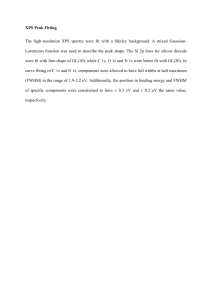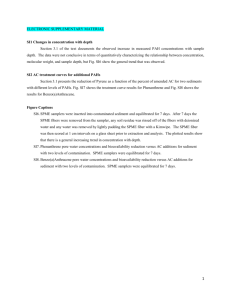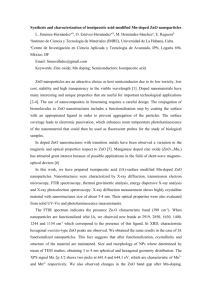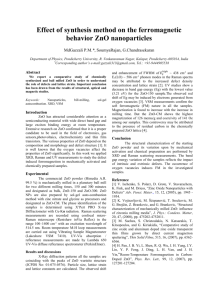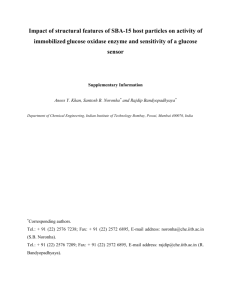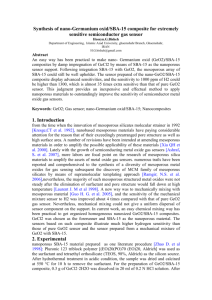SUPPLEMENTARY MATERIAL Fast determination of Ziziphora
advertisement
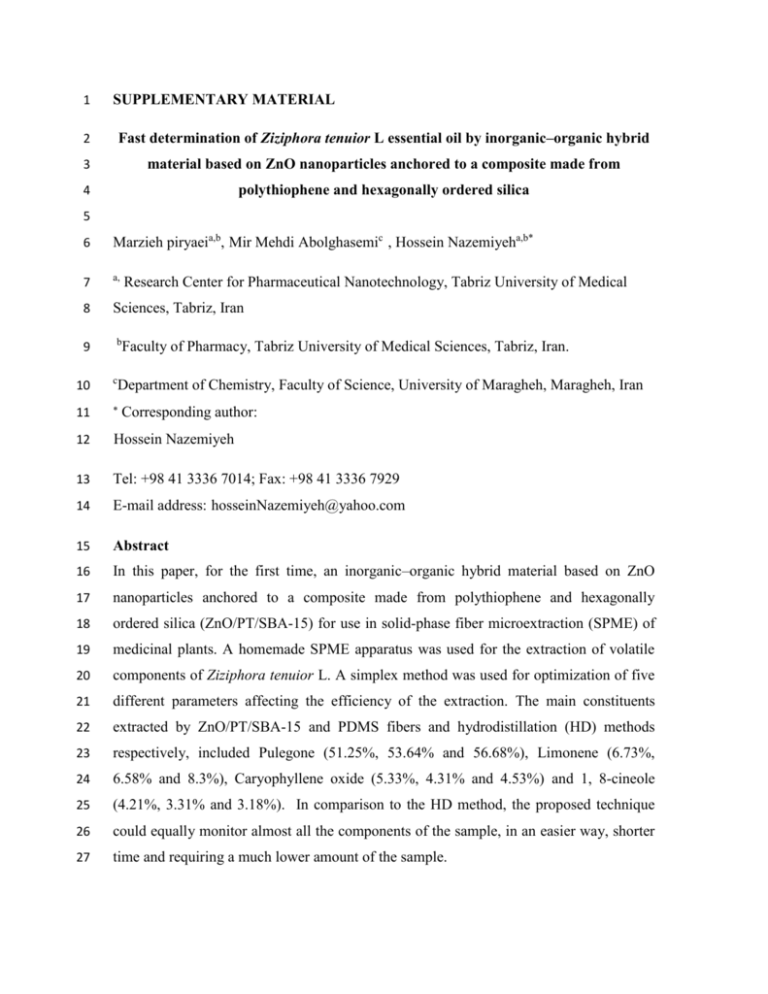
1 SUPPLEMENTARY MATERIAL 2 Fast determination of Ziziphora tenuior L essential oil by inorganic–organic hybrid 3 material based on ZnO nanoparticles anchored to a composite made from 4 polythiophene and hexagonally ordered silica 5 6 Marzieh piryaeia,b, Mir Mehdi Abolghasemic , Hossein Nazemiyeha,b* 7 a, 8 Sciences, Tabriz, Iran 9 Research Center for Pharmaceutical Nanotechnology, Tabriz University of Medical b Faculty of Pharmacy, Tabriz University of Medical Sciences, Tabriz, Iran. 10 c 11 12 Hossein Nazemiyeh 13 Tel: +98 41 3336 7014; Fax: +98 41 3336 7929 14 E-mail address: hosseinNazemiyeh@yahoo.com 15 Abstract 16 In this paper, for the first time, an inorganic–organic hybrid material based on ZnO 17 nanoparticles anchored to a composite made from polythiophene and hexagonally 18 ordered silica (ZnO/PT/SBA-15) for use in solid-phase fiber microextraction (SPME) of 19 medicinal plants. A homemade SPME apparatus was used for the extraction of volatile 20 components of Ziziphora tenuior L. A simplex method was used for optimization of five 21 different parameters affecting the efficiency of the extraction. The main constituents 22 extracted by ZnO/PT/SBA-15 and PDMS fibers and hydrodistillation (HD) methods 23 respectively, included Pulegone (51.25%, 53.64% and 56.68%), Limonene (6.73%, 24 6.58% and 8.3%), Caryophyllene oxide (5.33%, 4.31% and 4.53%) and 1, 8-cineole 25 (4.21%, 3.31% and 3.18%). In comparison to the HD method, the proposed technique 26 could equally monitor almost all the components of the sample, in an easier way, shorter 27 time and requiring a much lower amount of the sample. Department of Chemistry, Faculty of Science, University of Maragheh, Maragheh, Iran Corresponding author: 28 Keywords: ZnO nanoparticles anchored to a composite made from polythiophene and 29 hexagonally ordered silica (ZnO/PT/SBA-15) solid-phase fiber microextraction, 30 Ziziphora tenuior L 31 Experimental 32 Plant materials 33 The aerial parts of Ziziphora tenuir were gathered during the flowering period in summer 34 2013 from pave in the west of Iran. The aerial parts were dried in the shade (at room 35 temperature). A voucher specimen was deposited at the chemistry herbarium of this 36 laboratory under the code 1812 ZT. 37 Chemicals and reagents 38 Poly (ethylene glycol)-block-poly (propylene glycol)-blockpoly (ethylene glycol) 39 (EO20–PO70–EO20 or Pluronic P123) as surfactant were purchased from Sigma (Buchs, 40 Switzerland, www.sigmaaldrich.com). Zn(Ac)2, Li(OH)· H2O, Methylene chloride, 41 thiophene monomers, and all chemical solvents were obtained from the Fluka (Buchs, 42 Switzerland, www. sigmaaldrich.com) or Merck (Darmstadt, Germany, www. merck.de) 43 companies. The stock solution 1 mg mL−1 of PAHs was prepared in mixed methanol 44 solvents. The working solutions of above compounds were prepared by diluting the stock 45 solution with methanol and more diluted working solutions were prepared daily by 46 diluting these solutions with deionized water. All solvents used in this study were of 47 analytical reagent grade. Blank analyses were performed regularly to ensure that no 48 PAHs were present in laboratory reagents, atmosphere, or fibers. 49 Essential oils isolation 50 One hundred grams of air-dried aerial parts (leaves) of Ziziphora tenuir were ground to a 51 fine powder, and then put into a 1000 ml distillation flask. Five hundred milliliters of 52 distilled water was added and subjected to hydrodistillation for 4 h, using a Clevenger- 53 type apparatus as recommended by British Pharmacopeia. Oil was collected from the 54 condenser, dried over anhydrous sodium sulfate, and the yield of the sample was about 55 0.21% based on dry weight of the sample. The obtained essential oil was stored at 4 ˚C 56 until analysis by GC–MS. 57 GC–MS analysis 58 A Hewlett-Packard Agilent 7890A series GC equipped with a split/splitless injector and 59 an Agilent 5975C mass-selective (Agilent Technologies, Palo Alto, CA, USA, 60 http://www. agilent.com/chem) detector system were used for determination. The MS 61 was operated in the EI mode (70 eV). Helium (99.999 %) was employed as a carrier gas, 62 and its flow-rate was adjusted to 1 mL min−1. The separation of PAHs was performed on 63 a 30 m×0.25 mm HP-5 MS column (Agilent Technologies, Palo Alto, CA, USA) with 64 0.25 μm film thickness. The column was held at 50 °C and increased to 180 °C at a rate 65 of 15 °C min−1 and then raised to 260 °C at 20 °C min−1 and kept at this temperature for 66 5 min. The injector temperature was set at 260 °C, and all injections were carried out on 67 the splitless mode for 2 min. The GC–MS interface, ion source and quadrupole 68 temperatures were set at 280, 230 and 150 °C, respectively. Compounds were identified 69 using the Wiley 7 N (Wiley, New York, NY, USA) Mass Spectral Library. A homemade 70 SPME device was used for holding and the injection of the fabricated fiber into the GC– 71 MS injection port. The commercial SPME device and PDMS fiber (100-μm film 72 thickness) were purchased from Supelco (Bellefonte, PA, USA). The fiber was 73 conditioned in the injection port of a GC for 1 h. 74 Preparation of ZnO/PT/SBA-15 nanocomposites 75 Preparation the ZnO/PT/SBA-15 nanocomposite was synthesized following the 76 procedures described elsewhere (Zhang, Chen, Ma, Chen, Yang, & Zhang, 2010). Highly 77 ordered mesoporous SBA-15 was synthesized using a procedure reported by Zhao and 78 co-workers (Zhao et al., 1998). SBA-15 was thermally treated at 120 °C in a vacuum 79 oven to remove the physically adsorbed water. Then, 0.50 g SBA- 15 was immersed in a 80 mixture of 10 ml methylene chloride and 5 ml thiophene monomers. The mixture was 81 sonicated at ambient temperature for 1 h. When the methylene chloride and unadsorbed 82 thiophene had been slowly evaporated at 30 °C for 24 h under a vacuum oven, the 83 mixture was added to a solution of H2O/ethanol (volume ratio: 5/1), which contained 5 84 ml 30 % hydrogen peroxide aqueous solution and 4 mg FeCl3. The polymerization 85 proceeded under nitrogen atmosphere and pH=2 for over 12 h at 50 °C. The remained 86 product was directly precipitated into vigorously stirred methanol (six volumes), then 87 filtered off and washed with methanol several times, and eventually dried under vacuum 88 at 50 °C for 12 h to remove the physically adsorbed water molecules (Lee, Lee, Cheong, 89 Lee, & Kim, 2007). The PT/SBA-15 nanocomposite was directly immersed in 90 Zn(Ac)2/ethanol solution through sonication in order to adsorb Zn2+ adequately, and then 91 Li(OH) aqueous solution was added to form ZnO nanoparticles and the ZnO/PT/SBA-15 92 composite was successfully prepared (Vietmeyer , Seger, & Kamat, 2007) . Preparation 93 of the SPME fiber a piece of stainless steel wire with a 200-μm diameter was twice 94 cleaned with methanol in an ultrasonic bath for 20 min and dried at 70 °C. One 95 centimeter of the wire was limed with epoxy glue and the ZnO/PT/SBA-15 96 nanocomposite was immobilized onto the wire. The coated wire was heated to 50 °C for 97 48 h in an oven, gently scrubbed to remove non-bonded particles and assembled to the 98 SPME holder device. Finally, prepared SPME fiber was inserted into the GC injection 99 port to be cleaned and conditioned at 260 °C for 1 h in a helium environment. The 100 thickness of the uniform coating layer was calculated from the difference between the 101 coated and uncoated stainless steel wire and come out to be about 20 μm. The headspace 102 solid phase microextraction (HS-SPME) procedure SPME was performed with the 103 prepared nanocomposite fiber, mounted in its SPME device. The extraction temperature 104 was controlled using a thermostated oil bath (Abolghasemi et al., 2014). 105 106 107 108 109 110 111 112 113 114 115 Figure S1. The response (sum area of four main peaks of Ziziphora tenuir samples) for 116 the designed experiments mentioned in Table 1. 117 118 119 120 121 122 123 124 125 126 127 128 129 130 131 132 133 134 Figure S2. Effect of water addition on the extraction efficiency of the solid-phase 135 microextraction method. 136 137

